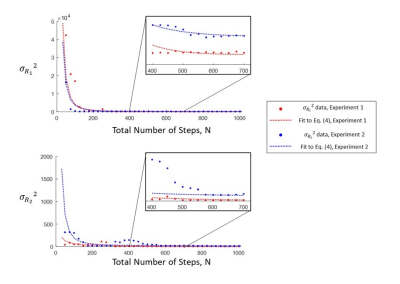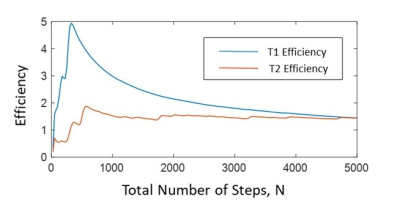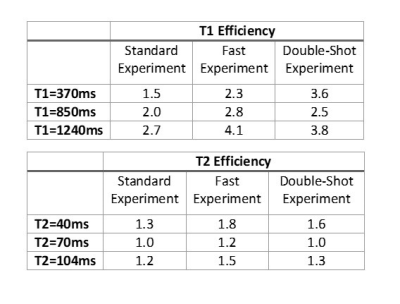2780
The statisitical error in FISP-MRF experiments1Physics, Case Western Reserve University, Cleveland, OH, United States, 2Biomedical Engineering, Case Western Reserve University, Cleveland, OH, United States, 3Radiology, Case Western Reserve University, Cleveland, OH, United States
Synopsis
The MRF framework has significant freedom in sequence design, increasing its utility and scope, but also the difficulty of determining an optimally efficient experiment. To address this challenge, a statistical analysis of MRF is used to develop a model relating the error in relaxation time quantification and the resulting experimental efficiencies to the number of repetitions in a FISP-MRF experiment. In general, T1 and T2 efficiencies peak prior to 1000 time steps, then decrease to constant values for larger time step totals. Therefore, the derived model can be used to design efficient MRF experiments.
Purpose
The MRF framework allows for significant freedom in sequence design, augmenting its versatility and scope of capabilities, but making experimental design to provide optimal efficiency challenging. This work presents a statistical analysis of MRF for an improved understanding of scan time efficiency.Methods
To understand FISP-MRF statistics, a model is derived for a simple experiment, then applied to experiments with varying input parameters.
Using analysis presented in Kara et al.,1 the MRF signal as a function R1=1/T1 and R2=1/T2 is modeled by a Taylor series expansion. Then, a dictionary entry corresponding to R1 and R2 is $$$\overrightarrow{D}\left(R_{1},R_{2}\right)\cong\overrightarrow{C}_{0}+\overrightarrow{C}_{1}\left(R_{1}-R_{1,0}\right)+\overrightarrow{C}_{2}\left(R_{2}-R_{2,0}\right)$$$ and a noisy signal with underlying R1,0 and R2,0 is $$$\overrightarrow{S}\cong\overrightarrow{C}_{0}+\overrightarrow{\eta}$$$, where $$$\overrightarrow{C}_{0}=\overrightarrow{D}\left(R_{1,0},R_{2,0}\right)$$$ and $$$\overrightarrow{C}_{i}=\frac{\partial\overrightarrow{D}}{\partial R_{i}}\mid_{R_{1}=R_{1,0},R_{2}=R_{2,0}}$$$ for i=1,2. Then, error due to noise in mapping Ri is $$\sigma_{R_{i}}^{2}=\sigma_{\eta}^{2}/Q_{i} \quad (i=1,2) \qquad (1)$$ where Qi is a function of $$$\hat{C}_{0}, \hat{C}_{1}$$$, and $$$\hat{C}_{2}$$$.1
For a simple experiment (constant flip angle, TR), $$$\overrightarrow{C}_{0}, \overrightarrow{C}_{1}$$$, and $$$\overrightarrow{C}_{2}$$$ become constant in the steady state. Therefore, $$\hat{C}_{j}=\frac{\overrightarrow{C}_{j}}{\sqrt{c_{j}+ C_{j,ss}^{2}N}} \quad \left(j=0,1,2\right)\qquad (2)$$ with constant cj and total number of acquired time steps N. Then, using Eq. (2), $$Q_{i}=\frac{\sum_{k=0}^{3}\alpha_{i,k}N^{k}}{\sum_{l=0}^{2}\beta_{i,l}N^{l}} \quad (i=1,2) \qquad (3)$$ where coefficients $$$\alpha_{i,k}$$$ and $$$\beta_{i,l}$$$ depend on the imaging sequence. In the large N limit, Eq. (3) implies that Qi becomes proportional to N; thus, $$$\sigma_{R_{i}}$$$ approaches $$$\sqrt{N}$$$, the expected statistical result for N repeated, independent experiments.
This model was tested in multiple FISP-MRF simulations and experiments, with varying flip angle distributions, constant TR and TE (6.98ms, 2.93ms), and N up to 10000 steps. The numerator of Qi is dominated by $$$\alpha_{i,2}N^{2}$$$ for clinically relevant values of N (<3,000 steps), so that $$\sigma_{R_{i}}^{2}\cong a_{i,0}+\frac{a_{i,1}}{N}+\frac{a_{i,2}}{N^{2}} \quad(i=1,2)\quad [N<3000] \qquad (4)$$
Simulated Qi for various FISP-MRF sequences reveal rapid increases in Qi early in the first 1000 repetitions, beyond which growth in Qi slows to the linear relationship in N predicted by Eq.(3). Therefore, the efficiency of a FISP-MRF experiment in mapping Ti, assuming approximately constant TR, is expected to be greatest prior to linear growth, after which the efficiency becomes approximately constant according to2 $$Efficiency=\frac{T_{i}}{\sigma_{T_{i}}\sqrt{T_{seq}}} \quad (i=1,2) \qquad (5)$$
The efficiencies of three experiments of differing durations
and/or acceleration factors are compared. Flip angle distributions based on Jiang et al.3
with constant TR (6.98ms) and TE (2.93ms) were used to image a 10 compartment
phantom on a 3T Siemens Skyra. In cases 1 (Standard Experiment) and 2 (Fast
Experiment), 1000 and 500 time points were collected with a single-shot
variable density spiral to produce undersampled (R=48) data sets in 6980s and 3490s
respectively. In case 3 (Double-Shot Experiment), 500 time points were
collected with two spiral interleaves per time step (30s between acquisitions),
to produce an undersampled (R=24) data set in 7010s. Monte-Carlo bootstrapping
was used to calculate $$$/sigma_{R}_{i}^{2}$$$ per voxel, from which average $$$/sigma_{R}_{i}^{2}$$$ was calculated over 5x5 ROIs.4
Results and Discussion
Fits of simulated Qi and experimental data using Eqs.(3) and (4) from two experiments, both with flip angle distributions based on Jiang et al., are presented in Figs. [1] and [2] respectively. Experiment 1 uses an initial inversion pulse, and Experiment 2 uses intermittent preparation pulses.5 In both cases, rapid increases in Qi, reflected by rapid decreases in experimental occur prior to N=1000, followed by linearity in N. Although intermittent preparation pulses do not affect linearity, the Qi and N proportionality is increased, resulting in lower $$$\sigma_{R_{i}}^{2}$$$.
In Fig. [3], the T1 and T2 efficiency of Experiment 1 is calculated from Qi data for varying values of N, assuming $$$T_{seq}=N \cdot TR$$$ (constant TR=6.98ms). An initial efficiency spike is followed by constant efficiency as Qi becomes linear in N.
Table 1 displays the Standard, Fast, and Double-Shot efficiencies for three phantom ROIs. The Standard is least efficient in all phantom ROIs, and the Fast is, in general, most efficient. On average, the Fast (Double-Shot) offers a 39% (25%) improvement in T1 efficiency and a 26% (25%) improvement in T2 efficiency relative to the Standard. That the Standard is least efficient agrees with the presented statistical model. Increased efficiency for the Fast compared to the Double-Shot suggests the aliasing noise decrease using two rather than one k-space interleaves per step is insufficient to warrant the increased acquisition time.
Conclusion
The statistical analysis of MRF for T1 and T2 parameterization is an informative tool for more efficiently using scan time. In general, relaxation time efficiencies reach constant values for large but clinically reasonable time step totals. Therefore, determining the number of steps to reach saturation by calculating Qi as functions of N, prior to an MRF-experiment, can result in more efficient imaging.Acknowledgements
NIH T32EB007509, OTF IPP TECG20140138.References
[1] Kara D, et al. Proc. ISMRM 2017:1350.
[2] Ma D, et al. Nature 495, 187-92 (2013).
[3] Jiang Y, et al. MRM 74:1621–1631 (2015).
[4] Riffe M J et al. Proc. ISMRM 2017:1879.
[5] Hamilton J et al. MRM doi:10.1002/mrm.26216.
Figures



